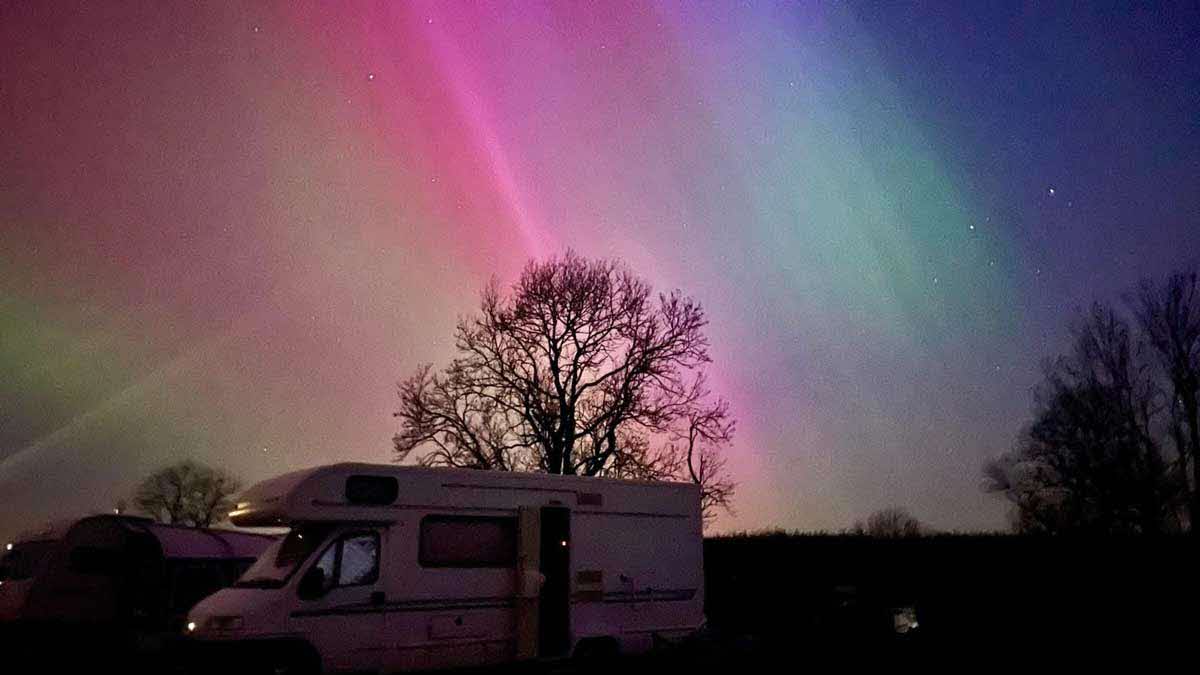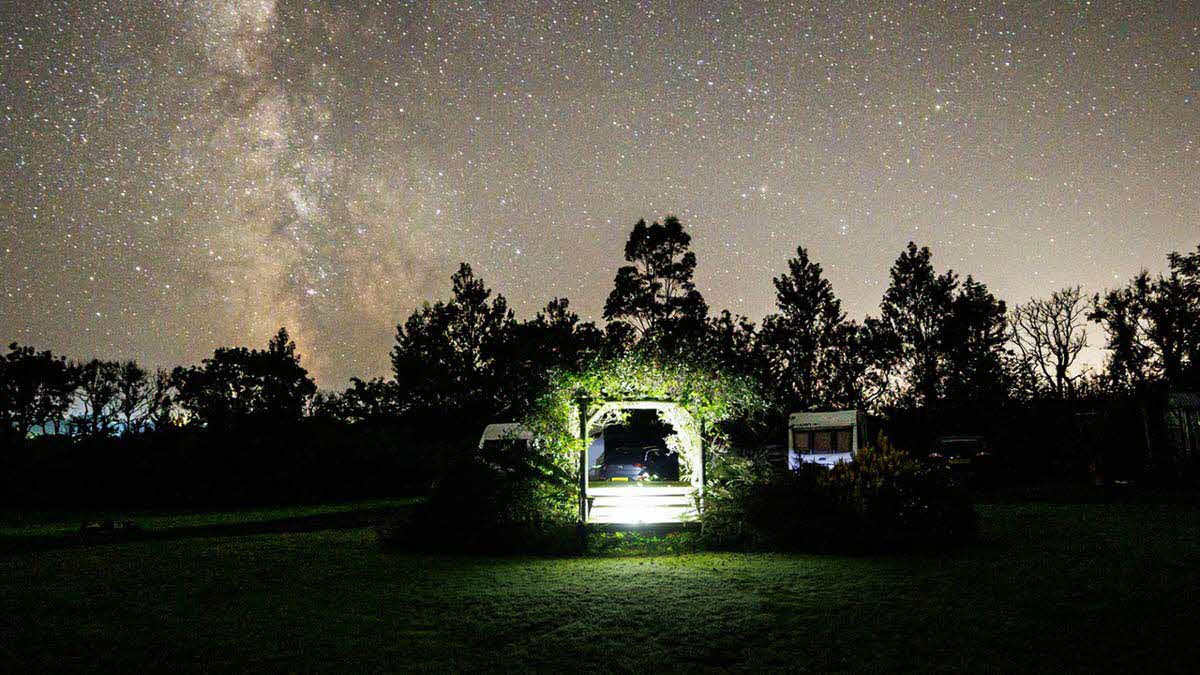Dark skies and our budding astronomer
Late last year, one of our members contacted the Club about the Dark Skies Initiative. This member loved staying on sites and was a budding astronomer. He, therefore, wanted to help other members and us to make the most of our Dark Skies sites.
In many of our information rooms, you can now find some tips on how to read the night sky as well as dates to pay extra attention to the sky. We would love to know if we have inspired any budding astronomers or whether you have seen anything unique in the night sky while staying across our Club Campsites. Like the Aurora seen across the UK on May 9th, we hope to witness something as eye-catching as soon as possible.
 Photo by Colin Teasdale
Photo by Colin Teasdale
Have a look at the Summer schedule and try and keep an eye out for these events in the sky when staying across our Club Campsite network.
|
Date |
Event |
|
June |
|
|
20th |
Antares 0.3 deg South of the Moon |
|
22nd |
Full Moon 01:08 hours (last quarter on the 28th) |
|
27th |
Saturn 0.1 degrees South of the Moon |
|
July |
|
|
1st |
Saturn 4 degrees South of the Moon |
|
3rd |
Jupiter 5 degrees South of the Moon |
|
5th |
New Moon 22:57 hours |
|
6th |
Venus (mag -3.9) 4 degrees South of the Moon |
|
7th |
Mercury (mag -0.3) 3.2 degrees South of the Moon |
|
13th |
First quarter Moon |
|
17th |
Perseid meteor shower begins (ends 24th August - maximum 12th-13th August) |
|
21st |
Full Moon (Moonlight interferes with meteor observing) |
|
24th |
Saturn (mag 0.9) 0.4 degrees South of the Moon |
|
28th |
Last quarter Moon |
|
30th |
Mars (mag 0.9) 5 degrees South of Moon & Jupiter (mag -2.1) 5.5 degrees South of Moon |
|
August |
|
|
4th |
New Moon |
|
5th |
Venus (mag -3.8) 1.7 degrees South of the Moon |
|
6th |
Mercury (mag 1.6) 7.5 degrees South of the Moon & Venus (mag -3.8) 6 degrees North of Mercury |
|
12th - 13th |
Perseid meteor shower maximum |
|
12th |
First quarter Moon |
|
19th |
Full Moon |
|
21st |
Saturn (mag 0.7) 0.5 degrees North of Moon and Neptune (mag 7.8 very feint) 0.7 degrees South of Moon |
|
26th |
Last quarter Moon |
|
27th |
Jupiter (mag -2.3) 5.7 degrees South of Moon |
|
28th |
Start of a-Aurigid meteor shower (until 5th Sept) also Mars (mag 0.8) 5 degrees South of Moon |
|
September |
|
|
1st |
a-Aurigid meteor shower maximum & Mercury (mag 0.5) 5 degrees South of Moon |
|
3rd |
New Moon |
|
5th |
Venus (mag -3.8) 1.2 degrees North of Moon |
|
10th - Nov 20th |
Taurid meteor shower |
|
11th |
First quarter Moon |
|
17th |
Saturn (mag 0.6) 0.3 degrees South of Moon |
|
18th |
Full Moon (partial Lunar eclipse at 02:45) |
|
22rd |
Uranus (mag 5.6) 5.7 degrees South of Moon (also September Equinox) |
Here are some tips for using the Summer schedule and to observe the night sky:
- Check our night sky diary – is there anything of interest to you?
- Plan how to observe based upon what you expect to see (see notes below).
- Can you see any stars? If so then conditions may be right for observation.
- Orientate yourself, do you recognise any star formations? Do you have access to a star chart?
- If using a torch for reading, a red filter is recommended as this colour will affect your eyes ‘dark adaption’ less. There are many free (point and show) smartphone apps that make observing objects very easy. At the very least, your phone may have a compass so you can orientate your location.
- Once you have recognised one constellation, the others become much easier to find by star hopping. So get to know major ones as they become pointers to the lesser ones.
- All stars rotate around a point directly above the North and South Poles rising in the east, culminating in the south and setting in the west as the Earth spins from west to east. So stars move across the sky throughout the night and their positions change slightly each day resulting in different constellations being on view throughout the year, so make sure you look at the right chart for the month or season.
- Check sky conditions and horizon in the direction you intend to observe.
 Member photo by Theresa Solly
Member photo by Theresa Solly
Naked-eye suggestions
- Enjoy the beauty of the night sky, learn some constellations and their mythology and how the stars got their fascinating names.
- The Milky Way is spectacular from good sites, weather permitting.
- Meteor Showers: Rule number one is to get comfortable and keep warm. A deck chair will support your back and head at a good angle. Our seasonal diary will give their predicted dates.
- Aurora: Though more common in Polar Regions they become rarer the further from the poles you observe. Due to their unpredictability, we will endeavour to notify Club Sites as and when these occur.
- The Moon & Planets are always fascinating to look at, note how their positions change against their starry background throughout the month.
- If you are lucky enough to be able to see a Comet whilst visiting a dark sky site, these are spectacular objects to see with or without optical aid – depending on size, distance and brightness.
Binocular astronomy
- Observing the night sky with binoculars is an excellent book for beginners. 10x50 are a favourite size as they offer a good magnification and are very portable. If used with a photographic tripod then much more detail can be seen in the night sky. Higher magnifications (20x80 etc.) will certainly require a tripod!
- The list of objects that a good pair of binoculars will reveal is extensive indeed such as Lunar features, the satellites of Jupiter, multiple star systems, galaxies (Andromeda can even be seen by naked-eye), clusters, comets and much more.
- The beauty of binoculars is that they are portable, reasonably inexpensive & are still useful should you lose your interest in astronomy.
Telescopic astronomy
- Telescopes can be extremely expensive and harder to transport safely as their mirrors are accurately aligned – unless you opt for a refractor. They also take longer to set up.
- I would advise to start with a good pair of binoculars and get plenty of advice from your local astronomy group before rushing out, potentially wasting a lot of money on the wrong type of instrument.
- Depending upon the site you have chosen to stay on, see if there is a public observatory within reasonable travelling distance and check their opening times – but remember to check the sky conditions. There may be a local astronomy society, we love to meet newcomers and give them as much advice as possible! You may even be tempted to try basic ‘astrophotography’?
Wherever you choose to observe, think SAFETY and be careful where you walk. Choose non-hazardous or dangerous areas. Any places dangerous in the day will be much more so at night!
Plan all this sensibly and safely and you will enjoy many years of astronomy.


